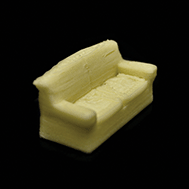3D printing of milk-based product
Abstract
We developed a method to perform direct ink writing (DIW) three-dimensional (3D) printing of milk products at room temperature by changing the rheological properties of the printing ink. 3D printing of food products has been demonstrated by different methods such as selective laser sintering (SLS) and hot-melt extrusion. Methods requiring high temperatures are, however, not suitable to creating 3D models consisting of temperature-sensitive nutrients. Milk is an example of such foods rich in nutrients such as calcium and protein that would be temperature sensitive. Cold-extrusion is an alternative method of 3D printing, but it requires the addition of rheology modifiers and the optimization of the multiple components. To address this limitation, we demonstrated DIW 3D printing of milk by cold-extrusion with a simple formulation of the milk ink. Our method relies on only one milk product (powdered milk). We formulated 70 w/w% milk ink and successfully fabricated complex 3D structures. Extending our method, we demonstrated multi-material printing and created food with various edible materials. Given the versatility of the demonstrated method, we envision that cold extrusion of food inks will be applied in creating nutritious and visually appealing food, with potential applications in formulating foods with various needs for nutrition and materials properties, where food inks could be extruded at room temperature without compromising the nutrients that would be degraded at elevated temperatures.



 Please wait while we load your content...
Please wait while we load your content...